Navigating responsibility as a graduate designer
In Conversation with: Anjali Tulpule
On navigating responsibility as a graduate designer
By: Fashion Revolution Australia
As part of our new interview series spotlighting emerging voices in Australia’s fashion landscape, we sat down with Anjali Tupule — a recent RMIT graduate and designer behind Tulpulé Atelier.
Anjali represents a new generation of designers navigating what it means to create consciously: balancing creativity and responsibility, tradition and innovation, and the realities of studying fashion in a time of profound industry change.
As a recent fashion student graduate and new designer, what excites you most about where the industry is heading right now?
What excites me the most about the industry right now is how sustainability is finally becoming a central topic in the fashion industry. In Melbourne especially, I have noticed there’s a real shift towards circular business models, not just through labels embracing new models, but also within the community. People are reselling pieces, renting garments for occasions they know they would never wear again, and up-cycling rather than throwing clothing away. Many of my peers and other young designers are leading this change, which is honestly exciting to witness.
I also appreciate that strong conversations are taking place in universities, as well as in the industry, and among designers about transparency, ethical practices, and inclusivity regarding both how labels operate and how consumers make purchasing decisions. As a new designer, it feels incredibly meaningful to step into the industry at a time when conscious consumerism, circular business models, and transparent production are being taken more seriously, as they should be.
That said, I do know we still have a really long way to go. Fast-fashion brands often market their clothing lines as ‘sustainable,’ which is known as greenwashing. This frustrates me to my core, and I think it is crucial for people to recognise the difference between that and labels that genuinely drive change.
What are some of the biggest challenges you see fashion students currently facing? (This could be during study or once they graduate)
I believe that young designers and graduates face numerous challenges. Balancing your own creativity with a brand or label’s wants when you’re working in the industry can be challenging. This, along with the pace of fashion, can also feel overwhelming. Keeping up with trends, particularly micro-trends, can be extremely exhausting. Having your creative voice within that could feel overwhelming and not align with the values one possesses when it comes to production and manufacturing within the industry. This is something I had to grapple with. The idea of slowing down in an industry that thrives on speed can feel extremely daunting and even a little scary.
Another challenge stemming from the previous would be navigating the tension between creativity and sustainability. At university, we are constantly encouraged to push the boundaries, experiment with many materials, and think in new and innovative ways. However, alongside this freedom, there is also a responsibility to design consciously and to choose fabrics with care, ensuring we reduce waste and consider the full life cycle of a garment. I think exploring sustainable production methods can be expensive and sometimes feel overwhelming, especially when the wider industry is so reliant on fast fashion. That said, I believe students and recent graduates are uniquely placed to lead change. They are questioning old systems, experimenting with new approaches to fashion, and investing in quality, ethics, and sustainability over quantity will ultimately lead to a positive reshaping of the industry.
What advice would you give to other young people who want to work in fashion while driving positive change?
I think that the most important thing is to start with curiosity and really take the time to learn about the fashion industry. That could mean talking to practitioners and students who are already making or working towards change in the industry, or diving into resources that expose fashion’s impact on the world socially, economically, and environmentally.
For me, watching documentaries like ‘War on Waste’ and ‘The True Cost’ (one of which I saw earlier this year at a screening and panel discussion hosted by the Fashion Revolution and Ethical Clothing Australia) was eye-opening. I also loved reading books like ‘Fashionopolis’ by Dana Thomas, ‘Wear Next: Fashioning the Future’ by Clare Press, and ‘Sundressed’ by Lucianne Tonti. Being curious, asking questions, and constantly wanting to learn more not only make you more aware of the fashion climate we live in but also spark meaningful conversations.
Conversation is the first step to driving change.
From there, I would focus on how you personally can make a difference. This might involve your own clothing choices, such as shopping second-hand, up-cycling, supporting labels that have sustainable and ethical values, or even trying something like the ‘Rule of Five’ challenge by Tiffanie Darke. I am currently doing this, and it has really opened my eyes to how much we over-consume. Limiting myself to purchasing five pieces of clothing has made me think more carefully about what I truly needed, rather than impulsively wanting things. If everyone followed these small steps, they would become a powerful large step towards reaching global climate targets.
Ultimately, I believe that gaining hands-on experience wherever possible is crucial. Intern or work with labels that prioritise sustainable and ethical values, organise clothing swaps, organise film nights for fashion documentaries for like-minded people, or simply start experimenting with ways to give your garments a new life. I think positive change doesn’t happen all at once, but rather each of these steps, big or small, adds up.
As a designer, I aim to create a positive impact through my label and designs. I am currently working on my label, which will champion longevity and circularity. I believe it is crucial for brands to focus on creating pieces that will truly stand the test of time and offer services for repair and maintenance.
I have also started a Substack called ‘The Capsule Journal Project’, where I explore conscious fashion, slow style, and building a wardrobe that lasts. I wanted to create something that focuses not on fleeting trends, but rather on understanding what you already have in your wardrobe and shaping it into a capsule collection that reflects one’s personal style.
Can you tell us about your upcoming collection — what inspired it, and what can we expect to see?
My label, Tulpulé (@tulpule.atelier) will officially launch in April / May 2026! This first collection will explore the intersection of the traditional Indian sari silhouettes and everyday Western wear. At its core, this collection focuses on circularity, longevity, and elegance. Every piece I have designed should seamlessly fit into a wardrobe while also being elevated for special occasions. There will also be an opportunity to inquire about one-off pieces.
Sustainability is central to this vision. I work with surplus and natural fibres, and follow a business model that prioritises high-quality pieces designed to last.
Much like my 2024 honours collection, ‘Caveat Venditor’ (which was a circular bridal collection that looks at the intersection between the Indian sari (a garment worn repeatedly) and the Western bridal archetype (typically worn once), this new collection will explore how these influences can create garments that go beyond one single occasion.
This new collection carries this ethos forward. It creates versatile pieces suitable for everyday wear that are adaptable for formal events and designed for longevity. It is a collection where practicality meets elegance, and tradition meets modernity.
For those who want to learn to make their own clothes or simply mend their own clothes, what’s your best piece of advice?
As cliché as this might sound. My best advice is to just go for it! The worst that can happen is you make a mistake, and that’s when you would bring out the unpicker, or the scissors, to try again. Mistakes are all part of the process. I would also say not to be afraid to ask for help. Whether it’s a family member, a friend, or even an online community, there will be people who would love to help you make or mend clothing!
I would also suggest considering the materials you might use. Consider deadstock and surplus!
However, I think the most important piece of advice is to never give up on a project and to always remember why you started it. Every stitch will contribute to your amazing finished piece, and you’ll learn something new each time you create something different! I recently learned how to hand embroider, and I had a blast, even though I was terrible at it initially.
On a more lighthearted note, what’s your favourite item in your closet and why?
This is really hard! But I think I would say my Arnsdorf white shirt. I know that sounds so simple, but it’s honestly my go-to for every kind of occasion. For my personal style, I really value staple pieces that I can wear on multiple occasions, depending on the occasion. To me, versatility is key. My white shirt has accompanied me everywhere, from picnics to dinners with friends and family, to long working days, important meetings, and job and internship interviews. It has been my quiet companion through so many moments in life.
I would also like to give special mention to my dad’s old leather jacket, which he gave to me, and my mum’s beautiful 2000s Hobbs dress, which she gave to me a few years ago. These pieces carry so many memories and stories, making them just as meaningful as my white shirt.
Anjali’s perspective is both honest and hopeful — grounded in the realities of being a fashion student, yet driven by a belief in slow, lasting change. Through her label Tulpulé Atelier and her writing on The Capsule Journal Project, she’s reimagining what circularity and longevity can look like for the next generation of designers.
Follow Anjali’s work:
Instagram — @tulpule.atelier
Substack — The Capsule Journal Project









